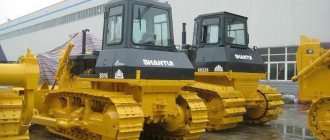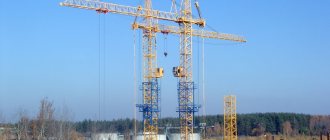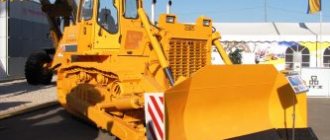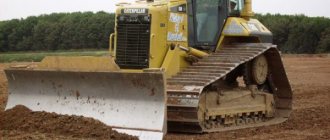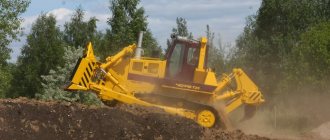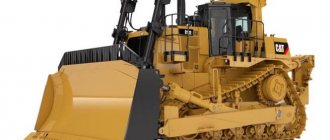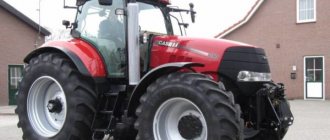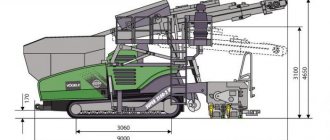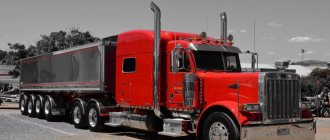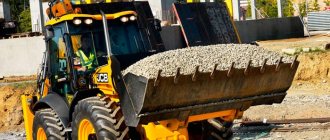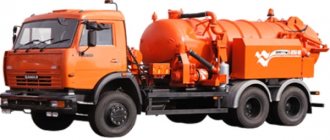The Chelyabinsk Tractor Plant produced the T 170 bulldozer from 1988 to 2002. But even today, bulldozers of this brand work flawlessly on construction sites in our country. This is an industrial heavy tracked tractor of traction class 10 with general and special purposes, designed to work in all climatic zones.
Initially, the design was based on the design principle of the T 130 tractor, but was supplemented by the ability to install a larger number of attachments and varieties of caterpillar tracks, the power of the power unit was increased, and the driver’s working conditions became more comfortable.
T 170 has undeniable advantages:
- simple and reliable assembly;
- power and high maneuverability;
- low cost.
Based on the ChTZ T 170 bulldozer, over the course of 14 years the plant produced more than 70 types of heavy agricultural equipment, which was present at all major construction sites and farm facilities of that time.
Considering this fact, there was an urgent need for maintenance. Thus, an additional complex “Uralremtrak” was created, which carried out repairs and maintenance of all types of equipment based on the T 170. Both enterprises are still operating today.
History of creation
Before continuing the story about the T-170, I would like to briefly recall the history of the plant, which is inextricably linked with the history of our country. It was ChTZ that in the 30s became the locomotive of tractor manufacturing in the USSR. It is difficult to overestimate the contribution that the enterprise made to the industrialization of the then young Soviet state. The decision to build a tractor giant in the Urals was made at the end of May 1929. Chelyabinsk was destined to become a new center of mechanical engineering. The choice of location was not accidental; it was facilitated by the industrial traditions of the region with developed infrastructure and qualified personnel. Few people know the fact that after Caterpillar refused to participate in the development of a master plan for the enterprise. In Detroit, the Chelyabinsk Tractor Plant bureau was organized, in which an international team of 12 Americans and 40 Soviet engineers worked together on the plan for the enterprise. The first workshops were opened in a solemn ceremony in August 1930. The plant project incorporated all the accumulated world experience in tractor manufacturing, which allowed the plant to become the largest enterprise at that time, which had no analogues in either Europe or America. It is impossible not to note the contribution that ChTZ made to the victory in the Great Patriotic War. During the war years, 18,000 different combat vehicles rolled off the assembly lines of the Ural plant, as well as countless amounts of ammunition, tank engines and spare parts for them. In the post-war period, the enterprise transferred production to a peaceful basis and expanded its activities. By the end of 1948, the plant was already producing 20-25 machines per day, and in the mid-50s, tractors from the Urals were bought by Austria, Finland, Egypt, Burma, Sweden, Afghanistan, Brazil, etc.
Since the late 1960s, modernization began at ChTZ and continued until the early 80s. During these years, a new, promising family of T-130 tractors was born. The plant produced its millionth tractor in 1984, and production peaked in 1988, during which 31,700 vehicles were produced. In the same 1988, a deep modernization of the T-130 gives birth to a new, more powerful T-170, the production of which will cease only in 2002.
Performance calculation
First of all, the theoretical parameters of the desired indicator are determined, then it is necessary to adjust it in accordance with the conditions of the future construction site. As a result, we get the real performance of the machine for a specific project.
Calculations are carried out according to the formula:
- Q is the required machine productivity, m3/h;
- q — bulldozer productivity per cycle, m3
- cm - operating cycle in time, min;
- e is a coefficient taking into account the slope angle;
- E: coefficient taking into account the productivity of the bulldozer
Cyclic (theoretical) productivity is determined by:
q = q1 x a
q1 — capacity of the dump device (m3)
a is a coefficient taking into account the filling of the dump
Specifications
The mass of the T 170 bulldozer is 17.3 tons as standard, and the specific pressure on the base is 76 kPa.
| General indicators | |
| Structural weight, kg | 15000 |
| Chassis type | crawler |
| Traction class | 10 |
| Base, mm | 2517 |
| Track, mm | 1880 |
| Engine | |
| Engine make | D180.111-1(D-160.11) |
| engine's type | Four-stroke diesel, turbocharged, multi-fuel |
| Engine power, kW (hp) | 125 (170) |
| Specific fuel consumption, g/kW*h (g/l.s.h.) | 218 (160) |
| Refill containers | |
| Fuel tank, l | 300 |
| Cooling system, l | 60 |
| Engine lubrication system, l | 32 |
| Final drive (each), l | 12 |
| Hydraulic system, l | 100 |
| dimensions | |
| Length, mm | 4600 |
| Width, mm | 2480 |
| Height, mm | 3180 |
| Specific ground pressure, MPa | 0,076 |
Engine
Initially, the bulldozer ran on a 160-horsepower D-160 engine. Two years later, it was replaced by the D-180 - a more powerful, turbocharged fuel supply and liquid cooling system, a 14.4-liter four-stroke diesel engine producing 180 hp. In addition, the power unit ensured high-quality operation of the equipment on any type of fuel.
The diesel engine was started from a P 23U gasoline auxiliary engine or an electric starter. For northern regions, all modifications were equipped with a pre-heater. In cold weather, the PZD 30 starting system was used. Engine life is 8000 hours before the first cap. repair.
According to power plant standards, it is safe, powerful and economical. The fuel consumption of the T 170 bulldozer is 220 g/kW per hour of operation. Trouble-free operation of the engine is ensured at temperatures from -40 to +40 degrees, which is of particular importance for the climatic conditions of Russia. The engine can operate for 10 thousand hours without the need for repairs. The fuel it runs on is diesel, condensate, kerosene. Depending on the modification, the engine is started by an electric starter or a starting motor (electric starter or carburetor). Air purification occurs in two stages to completely clean it of dust and impurities. The cooling system is liquid, and the lubrication is combined. The torque reserve is 25%.
Gear box
The circuit consists of a four-shaft gearbox, a permanently closed clutch and a power take-off shaft. Gears are switched by constantly meshed gears.
The bulldozer has 8 forward speeds and 4 reverse. Modifications with hydromechanical transmission are equipped with a six-speed gearbox, which ensures gear shifting under heavy loads without losing speed.
Depending on the operating conditions and purpose of the machine, the transmission can be mechanical or hydromechanical.
Bulldozer T-170 gear shift diagram
Some models allow you to install a 6-speed gearbox. This design is ideal for high-traffic vehicles in wetlands. First speed is blocked here.
Chassis system
All components and assemblies are mounted on a welded supporting frame equipped with tracked carriages, the mover of which is mounted on three points.
The semi-rigid suspension is complemented by a rigid balancing beam. The necessary working rigidity is provided by on-board spatial clutches. This suspension scheme provides excellent maneuverability on hard soils.
If the car was intended to be used in swampy areas, then long spars were installed on the frame. Vehicles for high cross-country ability are equipped with wide tracks on seven rollers, which creates low pressure on the ground.
The T 170 crawler bulldozer performed a fairly wide range of work thanks to 7 types of caterpillar tracks. He successfully coped with the assigned tasks, both on rocky and swampy terrain.
It is represented by caterpillars, which include 45 shoes. The support rollers are located on the sides of the machine, 7 pieces each. The track width is 0.9 m. This guarantees unhindered passage of the T 170 bulldozer in wetlands, sand or snow. Also, the lack of road surface and movement on sloping terrain are not a problem.
Hydraulics
The T 170 crawler bulldozer has a split hydraulic pump system. The pumps are installed with NSh-100 gear pumps, and the separate type assumes the presence of separate units as part of the system. They can be modified when installing various working parts.
To clean hydraulic fluid, a filter is provided that does not change the flow pressure, while cleaning it from elements 25 microns in size. The amplifier of the P160 system is 3-position and 3-spool. The pressure in the hydraulic system is 16 MPa, the safety valve turns it off at a pressure of 18-20 MPa.
All work of the attachments and the main blade is carried out through a separate hydraulic system based on the NSh 100 pumping station. It is installed directly on the engine. Hydraulic pump configurations were developed in different ways, depending on operating conditions and additional attachments. The modification of the machine depended on the hydraulic configuration installed on the bulldozer.
Electrics
The 24-volt electrical system runs on two batteries and a generator and is intended for:
- starting the car;
- lighting;
- sound and light alarm;
- power supply of instrumentation;
- heating, cooling and ventilation of the cabin;
- glass cleaning.
Hanging system
linkage mechanism for bulldozer T-170
There is a hinged system for attaching working equipment to the tractor. This system can be of two types, front and rear. Such a system consists of the following elements: hydraulic pump NSh-100, hydraulic distributor P160, hydraulic cylinders, a hydraulic pipeline system and two hydraulic tanks.
The NSh-100 pump is designed to create pressure in the system. The P160 hydraulic distributor directs the working fluid to the required hydraulic cylinders. Hydraulic cylinders, in turn, work directly with the equipment.
The T-170 is mainly combined with a variety of industrial equipment. Various types of dumps, rippers, pipe-laying equipment, uprooters. In agriculture, the T-170 is used mainly with plows on heavy soils and ploughs.
The bulldozer is mainly used in construction, which determines whether it is equipped with attachments. The machine can perform the functions of a ripper, a pipe layer, and can be mounted with a pile driver or a trailed crane.
For towed equipment, a pendulum or rigid tow hitch is installed.
The main addition to the bulldozer is the blade. There are 5 types of them according to their purpose:
- straight;
- hemispherical;
- turning;
- swamp;
- carbonic.
A ripper can be installed instead of a blade.
Areas of use
Today, bulldozers are actively used in road construction, construction, mining and other enterprises. The ability of equipment to cut, dig and move soil, rocks and other bulk materials is also used to mechanize such types of work as:
- leveling of territories and cleaning of gentle slopes;
- removal of fertile soil during construction site preparation;
- creation of shallow channels;
- arrangement of embankments;
- cleaning the bases for the foundations of structures;
- development of soil on slopes;
- filling trenches and other depressions;
- clearing the mining area;
- clearing large areas of debris, stones, snow, etc.
Device
The T-170 is a heavy tracked tractor of the 10th traction class with a wide range of applications.
1. General view of the tractor; 1 – running system; 2 – installation of long-stroke cylinders; 3 – hydraulic system; 4 – diesel; 5 – cabin: c – operator protection device “€ROPS-FOPS”; 7 – electrical equipment; B – fuel tank; 9 – platform; 10 – supporting system; 11 – transmission: 12 – rigid towbar; 13 – pendulum tow hitch
dimensions
All T-170 models were developed taking into account railway dimensions.
Base model:
- Length – 4210 mm.
- Width – 2480 mm.
- Height – 3250 mm.
- Track – 1880 mm.
- Base – 2880 mm.
Modifications have a swamp
- chassis – 2280 mm,
- width – 3230.
Mass characteristics:
- Basic – 15990 kg.
- Lightweight – 13000 kg.
- Pipelayer – 17700.
Cabin
You won’t find much comfort in the T-170 cabin, as in most domestic tractors. However, you can’t call them completely Spartan either. There is everything necessary for normal operation.
The cabin is made of a frame and is located at the rear. Below it is the transmission. The viewing angle allows the operator to fully control the work process, while the level of vibration in the cabin is minimal. This effect is achieved through supports. The driver's seat is adjustable.
The front panel is equipped with a number of indicators to assist the operator during operation. It meets all safety requirements. FOPS and ROPS systems perform the same function. For comfortable work in the cold season, a heater is provided, and in hot weather - an air conditioner (depending on the version).
The driver's seat can be changed to a comfortable position depending on the individual characteristics of the tractor driver. The cabin was heated with an oil radiator and cooled by air conditioning in hot weather.
On the dashboard you can constantly monitor the operation of the main systems and components:
- oil pressure;
- fuel level;
- clogging of hydraulics;
- the condition of the air purifier;
- crankshaft rotation speed;
- time worked.
The cabin was equipped with a protective frame that protected the tractor driver from falling stones or overturning the machine.
Control and steering system
Maneuvering the tractor is ensured by a lever control system. Changing the direction of movement, as well as braking, is carried out using a set of belt-type clutches. To change direction, the drive of one of the crawler tracks is partially blocked. The smoothness of the turn directly depends on the degree of blocking.
Controls, workplace equipment and tractor cab with hydromechanical transmission: 1 – left brake pedal; 2 – parking brake latch; 3 – right brake pedal; 4 – control lever for the front linkage system; 5 – start-up and control unit; 6 – bracket for fire extinguisher; 7 – hammer for breaking glass; 8 – rear linkage control lever; 9 – control panel; 10 – right steering control lever; 11 – left steering control lever; 12 – casing for placing the first aid kit case; 13 – gearbox control lever; 14 – battery compartment lock; 15 – locking lever; A – gear shift diagram; seat adjustment controls: B – forward-backward movement handle; C – load indicator; D – load control knob; E – height adjustment handle
Symbols for the purpose of control and monitoring elements: 1 – on (start) 2 – “ground” 3 – starter lock switch 4 – magneto 5 – electrical device (ammeter, voltmeter) 6 – cabin fan 7 – front window wiper (top) 8 – windshield wiper front window (lower) 9 – rear window wiper 10 – sound signal 11 – cabin lighting 12 – instrument lighting 13 – high beam (front hood lights) 14 – high beam (rear headlights) 15 – work headlight 16 – vehicle alarm (special vehicles ) 17 – fuel level 18 – hydraulic system filter 19 – engine meter 20 – flare engine heating (EFU) 21 – engine – speed 22 – presence of oil in the engine 23 – oil pressure in the engine 24 – coolant temperature 25 – air filter 26 – oil filter engine 27 – clogged oil filter in the transmission 28 – oil pressure in the transmission 29 – oil pressure in the transmission control system 30 – oil pressure in the gearbox 31 – oil pressure in the GMT 32 – oil pressure in the GMT at the outlet 33 – oil temperature in the GMT 34 – oil temperature in GTR 35 – gearbox lock – closed 36 – gearbox lock – open 37 – starter drive (engagement mechanism – on) 38 – starter drive (engagement mechanism – off) 39 – air damper – open 40 – air damper – closed 41 – starting motor clutch – on 42 – starting motor clutch – off 43 – decompressor mechanism – closed 44 – decompressor mechanism – open 45 – parking brake 46 – faster (starting motor gearbox – fast gear) 47 – slower (starting motor gearbox – slow gear) gear) 48 – direction of movement of the control lever (point – neutral position) 49 – neutral 50 – forward movement 51 – reverse movement 52 – left movement 53 – right movement 54 – bulldozer blade – floating position 55 – bulldozer blade – lift 56 – bulldozer blade – lowering 57 – bulldozer blade – left skew 58 – bulldozer blade – right skew 59 – ripper – floating position 60 – ripper – lift 61 – ripper – lowering 62 – rear linkage – floating position 63 – rear linkage – lift 64 – rear linkage – lowering 65 – ATTENTION, emergency condition 66 – work with ear protection
Weight of bulldozer T-170
In addition, the basic model is designed so that various attachments can be installed on the structure: a snow clearer, an excavator bucket, a shovel for conversion into a bulldozer. The support for the operator's cab contributes to comfortable work for the driver, as it dampens vibrations and provides good visibility due to the large glass area.
Exploitation
In 2002, the T 170 bulldozer was discontinued. But even today this machine can often be seen on construction sites. This speaks volumes about the ratio of the main advantages of equipment in this class - cost/quality.
The machine works with any soil. Easy replacement of attachments. The engine hour meter indicates the time for oil and lubricant changes.
Ease of transportation: the dimensions of the T 170 are designed for railway platforms and trailers.
There are never any problems with spare parts: Uralremtrak regularly produces spare parts today. You can also make a cap there. repair or carry out maintenance.
Speaking about the use of a tractor in various fields of activity, many highlight the main advantages and disadvantages:
Advantages:
- Machine reliability.
- The cost of the tractor is relatively low compared to its analogues.
- Maintainability.
- Operation in various climatic zones.
- Extensive dealer network of the ChTZ Plant, availability of spare parts.
- The tractor's engine life reaches 10 thousand engine hours.
- A significant plus is the ability of the T-170 to operate on various types of fuel.
Flaws:
- To transport a bulldozer on a railway platform, it is necessary to dismantle the attachments.
- The weak point is the friction clutches. Often need replacement because... They haven't changed since the T 130.
- Difficult steering (and in need of repair).
- Insufficient cabin sealing.
However, all this is compensated by the low cost, power and convenient operation of the T 170.
Tractor modifications
Currently, this device is available in many different configurations and modifications, of which there are about eighty. Each model produced by the plant is an improved version of old copies. As a rule, one of two types of engines can be installed in modified equipment. You can buy a T-170 bulldozer with a D-160 engine or a modernized D-180 unit with increased power up to 180 hp, which allows you to maximize the efficiency of agricultural work.
Buy spare parts for tractors T-170 and T-130 at EnergoTehStroy © Operator's cabin
The tracks were not maintained for more than six months; they simply tore, tearing off wings, boxes, batteries. In general, the quality of the factory assembly often leaves much to be desired. On the positive side, it can be noted that the factories that survived the emergence of the wild market, despite all the difficulties over the past 25 years, have modernized their machines, worked on creating new models with greater cross-country ability, increased productivity of the bulldozer blade, smooth adjustment of traction force, etc. .
